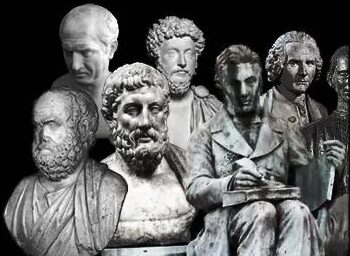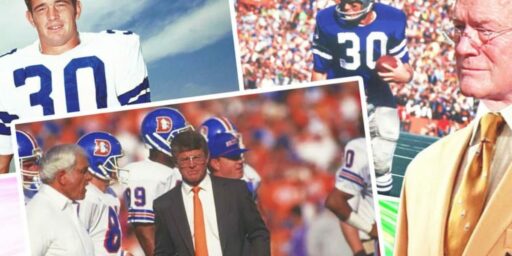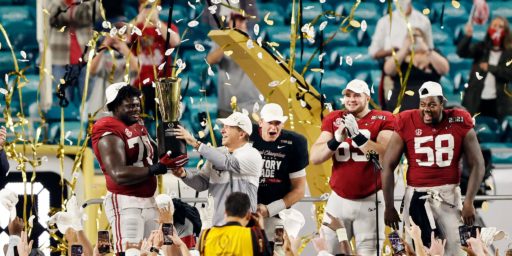JumboTron Not Just for Fans Anymore
ESPN’s Greg Garber has an interesting look at the JumboTron, those gigantic television monitors that grace most sporting venues. As the screens have gotten bigger and the picture better, they are good for much more than hawking souvenirs and showing scores and replays. They can actually influence games.
It was, to the naked eye, a forgettable play in a forgettable loss in an extremely forgettable season. And yet, it sparked a revelation. In the sixth game of the 2004 season at Detroit, Tiki Barber caught a screen pass from Kurt Warner and found himself completely lost. He had no idea where his blockers were. “I didn’t know where I was because I ran into the back of my lineman,” the Giants running back remembered earlier this season at Giants Stadium. “The JumboTron was literally right there, so I looked and said, ‘Oh, there they are.’ ”
Barber, matter-of-factly, reports he often uses the big screen as a frame of reference during actual plays. “Pretty cool, huh?” he asked.
[…]
It’s a startling demonstration of hand-eye-brain coordination — like a baseball outfielder glancing away from a fly ball to gauge his distance from the wall — and it likely happens in nearly every NFL game. By breaking the video down (and slowing it down) you often can see the unmistakable tilt of the head upward toward the screen. Today’s athletes, part of this technological, video-oriented age, say they use the big screen during plays to give them an on-field edge. And there’s more. The JumboTron, developed for the entertainment and edification of fans, has become an interactive tool for coaches and players to improve their chances of winning. Used for between-play adjustments and replay challenges as well, the big screen — all-knowing, all seeing — is changing the way the game is played.
That professional athletes would use every tool at their disposal to their best advantage is not surprising, although this particular development is rather new. And it’s not just the players who use the screens to their best advantage.
Some teams have built-in home-field advantages. The Dolphins have the debilitating moist heat of Miami in September. The Patriots have thrived in the snow of New England. The Seahawks similarly seem to love the rain in Seattle. The Broncos routinely leave opponents gasping in the thin, mile-high atmosphere at Invesco Field.
And now, courtesy of the new technology, we bring you a more subtle and insidious home-field advantage — the clever big-screen operator. Meet Some teams have built-in home-field advantages. The Dolphins have the debilitating moist heat of Miami in September. The Patriots have thrived in the snow of New England. The Seahawks similarly seem to love the rain in Seattle. The Broncos routinely leave opponents gasping in the thin, mile-high atmosphere at Invesco Field.
And now, courtesy of the new technology, we bring you a more subtle and insidious home-field advantage — the clever big-screen operator. Meet Mark Eisenstadt, the Jacksonville Jaguars’ senior producer of game day and special entertainment. He has two objectives for each game.
First, give the fans something viewers can’t see at home. Second, assist the home team.
“The best thing is when you look down at the field and you see Coach [Jack] Del Rio looking up at the video board, wondering whether he should throw the red flag or not,” Eisenstadt said.
At that point, Eisenstadt’s crew hustles to get the video up so that Del Rio doesn’t have to wait for TV to go to replay.
“There is a great sense of accomplishment when he actually does throw the flag based on our replays,” Eisenstadt said. “Any time we can help our team win on the field, it’s just added satisfaction for us.”
“The guy who is tapped into the JumboTron,” said Jim Mora, the Atlanta Falcons head coach, “is like the guy from the Wizard of Oz behind the curtain. I use it in almost every game. My vision is better with JumboTron than it is on the field, especially on offense when I know where the ball is going to go.”, the Jacksonville Jaguars’ senior producer of game day and special entertainment. He has two objectives for each game. First, give the fans something viewers can’t see at home. Second, assist the home team. “The best thing is when you look down at the field and you see Coach [Jack] Del Rio looking up at the video board, wondering whether he should throw the red flag or not,” Eisenstadt said.
At that point, Eisenstadt’s crew hustles to get the video up so that Del Rio doesn’t have to wait for TV to go to replay.
“There is a great sense of accomplishment when he actually does throw the flag based on our replays,” Eisenstadt said. “Any time we can help our team win on the field, it’s just added satisfaction for us.” “The guy who is tapped into the JumboTron,” said Jim Mora, the Atlanta Falcons head coach, “is like the guy from the Wizard of Oz behind the curtain. I use it in almost every game. My vision is better with JumboTron than it is on the field, especially on offense when I know where the ball is going to go.”
Since success breeds emulation, especially in the NFL, there will be 31 other Mark Eisenstadts before long. One suspects that it will not take the League long to react to this by making new rules taking control of the JumboTron, or at least game video, away from the home team and giving it to officials while the game is in progress.






I agree with you that the leagues will have to address this soon. It will be an interesting, and heated battle when it happens.
In a sense it is similar to the telecommunications systems that teams use. When one side loses theirs, the other has to go without until the problem can be fixed in order to keep things fair.
I can’t see how a similar fix is possible with the JumboTrons. As the piece pointed out, their primary purpose is entertainment, and that’s where pocketbooks become involved. Even instant replay is a help in keeping the TV generation entertained between plays.
The Seahawks similarly seem to love the rain in Seattle.
That guy doesn’t know what he’s talking about. The Seahawks’ first 28 games at Qwest field were rain-free – in fact, the first time it ever rained on a game in that stadium was Oct. 23 against Dallas – a game the #1 offense in the league won 13-10. It’s the 12th Man that makes their home field so advantageous, not the weather (though better knowledge of how the wind works in there is certainly a factor).